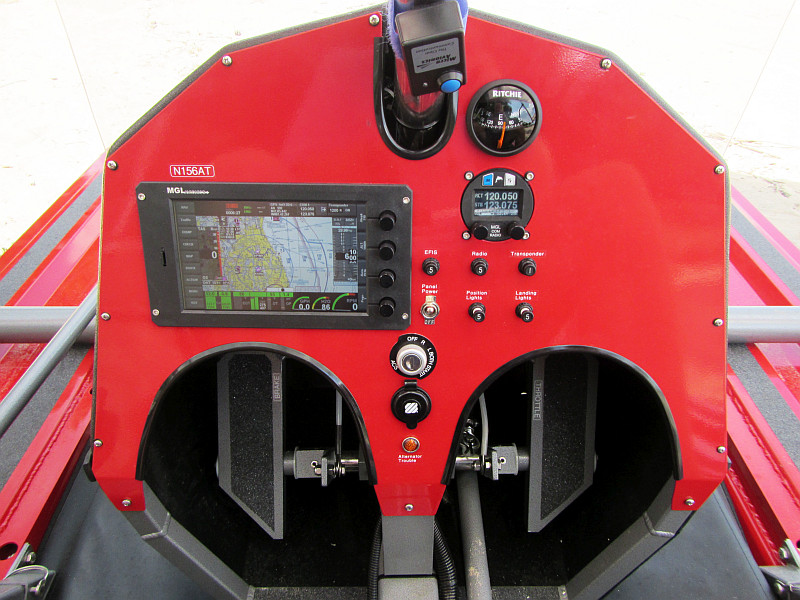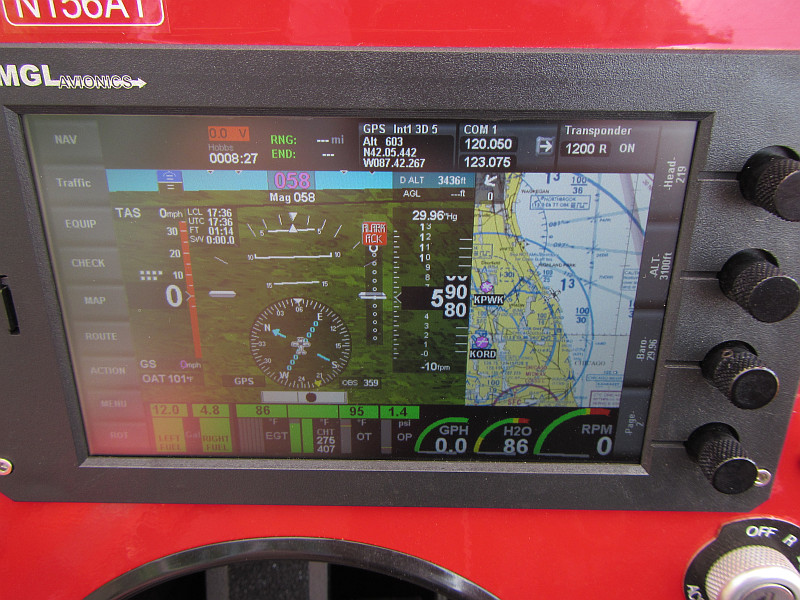
A popular upgrade option for the Cygnet is to use a moving map GPS display such as the MGL Discovery Lite instead of standard instruments. These are sometimes called ‘EFIS’ which stands for electronic flight information system, and sometimes called ‘glass panel’. By either name, it simply means that a computer screen replaces the traditional round gauges, sometimes referred to as ‘steam gauges’. The advantage of a glass panel is how much information can be displayed on the screen. ALL the standard instruments can be displayed on the screen instead. And the readings can be displayed in limitless ways on that screen. In the view shown here, the Cygnet’s GPS position is displayed on a chart, so you can always see exactly where you are. As you fly around, the map moves so your position is in the center of it. That’s why it is often called a ‘moving map’ display.

With a twist of the knobs, you can flip through various screens, and even create custom screens that display exactly the information you want for that screen. You can zoom in and out on the moving map to see exactly where you are in relation to the edges of airspace boundaries and no-fly zones. The EFIS has an airspeed meter and altimeter built in. It displays engine rpm, temperatures and pressures, fuel flows, fuel levels, and whatever other sensors you want to connect. The more measurement data you would like to be able to see, the more an EFIS makes sense. If you are using individual gauges, and want to measure a lot of things, you can run out of space for all the gauges. But with an EFIS multi-purpose screen, you have the option of connecting almost unlimited sensors and displaying that data however you want on all your screens.

Even though an EFIS can display a lot of data, it can also simplify how you track all that data. Readings can be ‘in the background’ unless they cross a user-adjustable level. You can enable high and low alarms which flash a WARNING notice in the center of the screen and give you a voice warning if the limits are approached or exceeded. Colors change from green to yellow to red according to the customized settings. So you can set things up so your readings are all displayed in green when everything is normal, yellow when things get a little bit high or low, and red when things get serious.
It is typical to have your airspeed, altitude and engine instruments displayed superimposed on your screen. In the picture above and in the closeup below, all the engine data is shown along the bottom of the screen. It is all green, so easy to see at a glance that none of the engine instruments are above their range. In this case the engine is not running, so RPM is at zero. Because the engine is not running, the alternator is not putting out any voltage. That’s why at the top left you can see 0.0 V in red. You can also see airspeed in red because it is reading 0 as this Cygnet is stationary inside the hangar.

For an aircraft like the Cygnet, which one you choose is purely personal preference. The glass panel does have some advantages, especially if you are also adding other electronics such as a radio, transponder, and/or ADS-B. The advantages increase if you are doing a lot of flights between airports.
For example, if you are adding an installed radio to your aircraft (rather than using a hand-held), you can control the radio from the EFIS screen. This means you can buy a ‘remote’ version of the radio that is less expensive because it does not have its own screen. You use the EFIS to control the radio. When you are approaching a particular airport, your screen will show you the various frequencies at that airport such as Tower, Ground, and Automated Weather. Just tap the button on your EFIS screen, and your EFIS tunes your radio for you. Similarly, you can save a few dollars by getting a screenless ‘remote’ version of the transponder and control it from the EFIS screen . You can see the transponder and radio (Com 1) controls at the top right of the screen above. Tapping either of those opens them up in bigger windows for ease of use.

If you are going to add ADS-B capability (required in some airspace starting in 2020), the EFIS will display other air traffic and weather information for us as we fly. The EFIS displays that information without you having to buy a separate screen such as a phone or tablet.
In conclusion, if you really want to add a lot of instrumentation and capability to your Cygnet, the EFIS is the cost-effective high tech way to do it. If you are happy to view your GPS position and/or ADS-B traffic and weather on a tablet or phone screen, and don’t mind tuning your radio manually, you can save a few dollars with standard individual gauges.
Leave a Reply